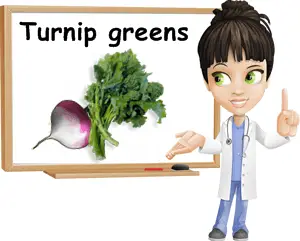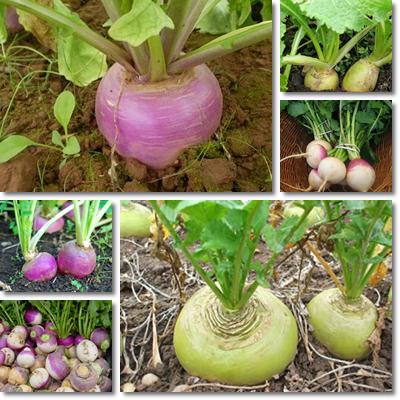Turnip tops or turnip greens are the dark green leaves of the turnip vegetable (Brassica rapa). Although they are quite bitter if the vegetable is left to mature, they are remarkably nutritious. Turnip greens are rich in vitamin C and vitamin K and boast incredible antioxidant properties due to a high lutein and zeaxanthin content. They are especially good for supporting blood coagulation, bone and eye health, digestive system function and reducing inflammation levels.
Eating turnip tops is good for your vision and increases calcium absorption in bones as well, resulting in strong, healthy bones and teeth. It has further benefits for cardiovascular health, contributing to healthy blood cholesterol levels and weight management. Just like mustard leaves, turnip greens go well with rice or meat dishes, but can also be added to hot chicken salads or mixed with other baked vegetables, preferably sweeter varieties to balance out their bitter, leafy green taste.

Turnips are available all year round but considering the vegetable’s affinity for cold weather it is best to harvest or purchase them during winter and spring. Turnip tops are usually sold together with the turnip root (see benefits of turnip root) For a more palatable culinary experience, choose smaller, younger turnips with healthy-looking green foliage. Don’t buy turnips with yellow or highly bruised leaves. The greener the leaves, the better: dark green turnip greens are the richest in vitamins and minerals. The downside of this is their accentuated bitter taste.
How to make turnip greens less bitter
How can you take off some of the bitterness of turnip tops? First of all, cook the more mature turnip greens instead of eating them raw. The general rule of leafy greens is: the older/larger the leaves, the more pregnant, often bitter the taste. Secondly, change the first round of water when boiling them. By throwing away the water you first boiled your turnip greens in you also discard the bitter compounds the vegetable exuded during the boiling process. Just know that you may also lose some nutrition as well since water-soluble vitamins (B vitamins and vitamin C) and minerals tend to leak into cooking water.
What are the benefits of turnip tops?
Being a dark green color, turnip leaves are a great source of pro-vitamin A in the form of the antioxidant beta-carotene (50% of daily requirements). Beta-carotene is a natural pigment responsible for the orange colors in pumpkin and carrots and even yellow-orange autumn leaves. The body converts it in vitamin A using fat from our diet. Most green, leafy vegetables are rich in the antioxidant, including but not limited to turnip greens, beet greens, collard greens, mustard greens, patience dock, chard, parsley, watercress and more.

The high content of beta-carotene in turnip tops makes them ideal for eye health. Beta-carotene not only boasts provitamin A activity, meaning it is made into vitamin A into the body, but also has a strong antioxidant activity, protecting the retina of the eye from free radical damage from blue light. Similar to vitamin A, this famous carotene is thought to offer protection against lung cancer in first-hand smokers especially via its antioxidant and immune system-boosting properties.
Lutein and zeaxanthin (around 40% of the RDA, recommended daily intake) are both vitamin A precursors with powerful antioxidant activity. They contribute immensely to eye health and help in the prevention of macular degeneration or loss of central vision due to old age. Research shows that both lutein and zeaxanthin accumulate in the retina and an area called the macula lutea, where they exert a shield-like action, blocking free radicals from light and preventing them from producing any damage.
Turnip greens are particularly rich in vitamin K and contain 3 times more calcium than the turnip root. The vitamin K in turnip greens increases calcium absorption in bones and helps strengthen them. Eating turnip greens favors teeth health as well due to the high content of both vitamin K and calcium. However, because the vitamin favors blood coagulation, if you are taking anticoagulant medication, it is important to talk to your doctor about what amount of green leafy vegetables is safe for you to eat.
Eating turnip tops is generally good for cardiovascular health. Vitamin K ensures calcium deposits in bones, not on artery walls (or joints) thus preventing atherosclerosis, a condition in which deposits on artery walls break and are released into the bloodstream, resulting in possible life-threatening blockages.
Other significant health benefits of turnip greens, related to the high vitamin K content (350% of the RDI) include: prevention of blood loss and anti-inflammatory activity. Vitamin K is important for blood coagulation and reduces the levels of Interleukin-6, a protein thought to cause inflammation and related chronic diseases (coronary heart disease, cancer).
Last but not least, turnip greens are a great source of vitamin C, providing about 1/3 of the recommended daily intake required for preventing a deficiency. This means that regular consumption promotes collagen production, provides antioxidant protection, helps reduce inflammation and increases the body’s natural response to bacterial infections. Vitamin C-rich foods such as turnip tops help prevent saggy skin and maintain blood vessel integrity as a result of increasing the production of collagen.
Conclusion
Because the darkest and most bitter leaves are the healthiest, you might need to cook turnip greens in order to make them more palatable, unless you enjoy the taste of bitter leafy greens. You can pair them with other members of the Brassica family such as kale, even mustard greens or spinach, saute them, spice them up, maybe add diced chicken breast, sunflower seeds or sesame seeds and olive oil as a healthier salad dressing to make the leafy green both appetizing and incredibly nutritious. Another idea would be to pair turnip greens with rice. You can also make turnip greens into pastry filling, pizza topping or add them to stews.
However, remember that cooking heat destroys vitamins, with 10 minutes of regular boiling reducing the content of certain vitamins with up to 30% or 50%, especially vitamin C. Overall, considering turnip greens are packed with vitamins and minerals and extremely low in calories (20 kcal/100 g), they remain a great option for a healthy diet and are extremely figure-friendly.
